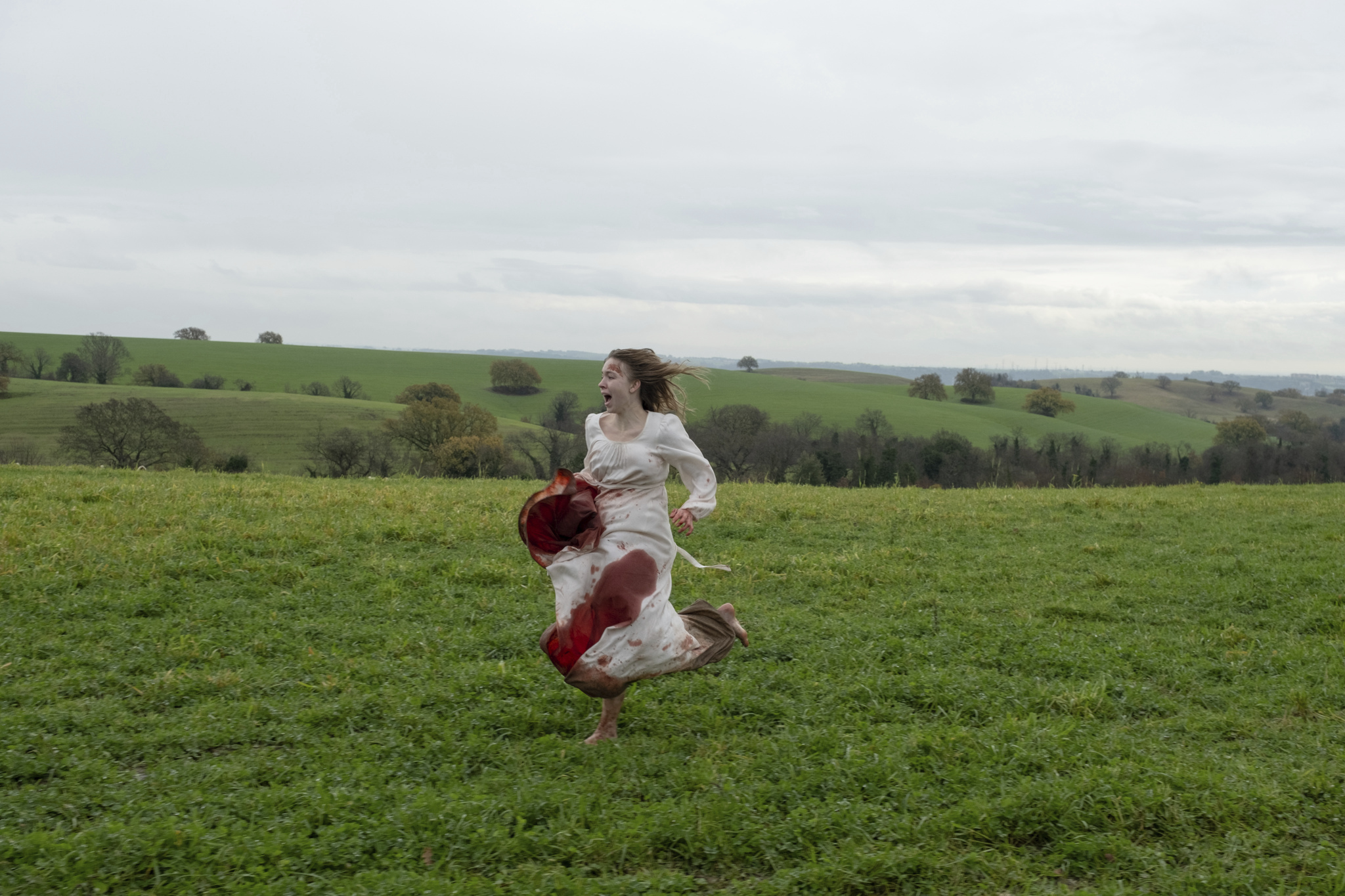
St. Bartholomew was flayed alive. St. Lawrence? Grilled to a crisp. St. Lucy and St. Agatha are often depicted carrying the symbols of their martyrdom around on small dinner plates, a pair of poked-out eyeballs in Lucy’s case, a set of severed breasts in Agatha’s. The lore of Catholicism is gruesome enough to fill a thousand horror movies. A picture in which a demure-but-hot young nun is lured to a spooky-opulent Italian convent for nefarious purposes isn’t such a stretch.
In Immaculate, directed by Michael Mohan and written by Andrew Lobel, Sydney Sweeney plays meek, devoted Sister Cecilia, a sweetheart from Detroit who has chosen to dedicate her life to Christ. There’s no way around it: she’s adorable, and the customs officers who detain her upon her arrival in Italy, riffling through her little 1960s-style hard-shell going-away suitcase, can’t help making crude remarks in their native tongue about her thinly veiled va-va-voom essence. She’s in a rush, she tells them impatiently; she’s got to take her vows that evening, and she mustn’t be late.
When Cecilia finally arrives at the convent, a sepia-toned, art-filled treasure deep in the Italian countryside, the priest in charge, Father Tedeschi (Álvaro Morte), greets her warmly, promising to translate anything she doesn’t understand; he’s patronizing her in plain sight, but she’s grateful for it. She hustles into her habit—a simple smock of drapey cream-colored jersey topped by a side-buckled black tabard, so chic it could have been plucked from the Row’s showroom—and makes it to the altar with time to spare. After eagerly swearing off sex and worldly goods forever—and, less eagerly, kissing the ring of the gnarly old bishop who’s officiating—she attends a big party for all the new recruits, and the unconsecrated wine flows freely. So far, so good.
Hardly. We’ve already learned from the movie’s prologue—a brief sequence in which a panicky young nun attempts to flee that convent in the dark of night, only to be mowed down by a fleet of angry nuns in flapping robes—that evil lurks in this supposedly sacred sanctuary. Its sinister secrets include a basement laboratory, a grody old religious relic, and a male authority figure who has found new and novel ways to control women, though that’s admittedly not so tough to pull off when you’re part of an institution that has survived for some 2000 years by doing just that.

Yet Immaculate puts that metaphor right up front and just leaves it there, which makes it more potent rather than less. Instead of twisting the storyline to try to make a point about, say, the church’s stance on abortion, Mohan and Lobel treat the institution’s misogyny as a given. That gives them the freedom to spend the movie’s fleet runtime riffing on classic Catholic miracle stuff (a nun seemingly graced with the gift of stigmata proudly shows off her seeping palm) and showcasing Sweeney’s Easter lily freshness. She’s also a producer on the film, and this role—that of a classic midwestern naif unwillingly cast in the role of blessed Madonna—suits her perfectly. In one of the movie’s most gorgeously staged scenes, she’s dressed like a Renaissance Virgin Mary ready for the May Crowning, the Catholic Church’s own version of Beltane. There she stands, draped in celestial blue silk with golden curlicues nestled in her hair, surrounded by her adoring sisters, looking miserable as heck. When she signed on to become a bride of Christ, this wasn’t what she was expecting.
Sometimes Mohan yields to the conventions of modern horror filmmaking: There are some jump scares and classic gross-outs (faces bludgeoned right down to the starey eyeballs, the grisly removal of a certain body part, glimpsed discreetly through a keyhole), and you should be prepared for maximum lashings of fake blood. Immaculate appears to have been partly modeled on the giallo tradition, exemplified by the stylishly gory films made by Dario Argento and Mario Bava in the 1970s. In places, the movie’s terrific score, by Will Bates—including a whimsically tinny harpsichord passage, and a thumpingly percussive interlude that grooves to the spirit of Goblin’s Suspiria theme—references those films directly, and with a sense of wit.
But Immaculate’s visual vibe is less glossy and more quietly satiny than classic giallo. The film was shot in and around Rome, sometimes in actual musty catacombs; you can practically feel the dust motes invading your nostrils. Mohan and his cinematographer (Elisha Christian) and production designer (Adam Reamer) have apparently taken great pleasure in building the movie’s elegant, brooding atmosphere. A scene in which the young nuns bathe together, fully clothed, has the dreamy, mossy quality of a Deborah Turbeville photograph, with some softcore titillation thrown in: the sisters are fully clothed in muslin nighties that turn translucent when wet, though the effect is more winkingly tasteful than steamy. Even so, Immaculate is never too tasteful, and it goes for broke as it winds toward the finish. The movie’s shockeroo ending made me wince, and it made me laugh. It’s bad-gal blasphemy of the highest order. Now—where can I get my hands on one of those habits?
More Must-Reads from TIME
- Donald Trump Is TIME's 2024 Person of the Year
- Why We Chose Trump as Person of the Year
- Is Intermittent Fasting Good or Bad for You?
- The 100 Must-Read Books of 2024
- The 20 Best Christmas TV Episodes
- Column: If Optimism Feels Ridiculous Now, Try Hope
- The Future of Climate Action Is Trade Policy
- Merle Bombardieri Is Helping People Make the Baby Decision
Contact us at letters@time.com